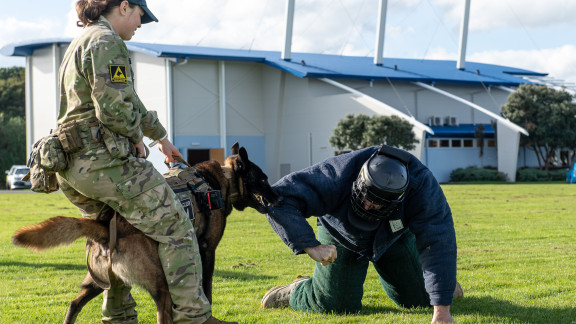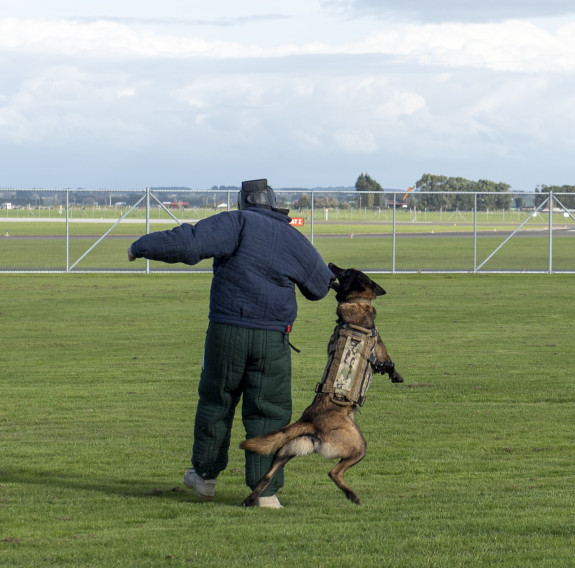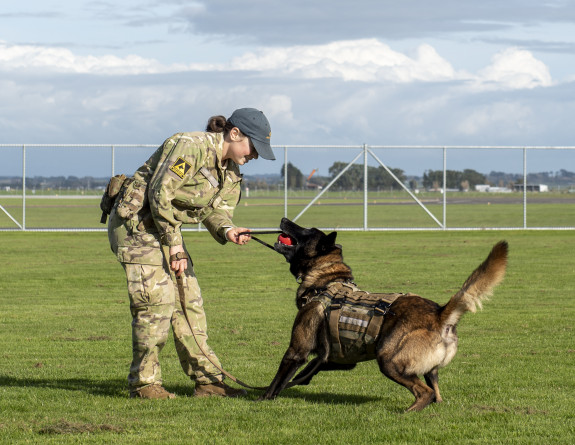Base Commander tests dog’s bite
Not many people willingly put themselves in the path of a Military Working Dog in attack mode, but Ohakea’s Base Commander, Group Captain Rob Shearer wanted to find out first-hand what the dogs were capable of.
29 June, 2023
Group Captain Shearer tested the ability of Dave the Belgian Malinois during a recent visit to the dog section’s temporary facilities on base. The Military Working Dog (MWD) Unit will be moving to a brand new permanent facility when it is completed later this year.
“I feel like it should be a gladiatorial contest, but I think it be more like me being fed to the lions,” he joked.
Crucial pieces of equipment for the activity were personal protective equipment, including a helmet and protective suit. While a bit ungainly, the gear is designed to stop the wearer from harm resulting from the MWD.
GPCAPT Shearer came away from the demonstration unhurt, but in no doubt of the power the dogs could unleash.

Military Working Dog Dave packs a gnarly bite
“It feels like I was overwhelmed by this very agile and powerful creature. There’s a certain sense of comfort having the suit on but also sobering in the sense that if you didn’t, it was going to be very painful and consequential.”
The demonstration confirmed the importance of introducing the dog team into service on the base, GPCAPT Shearer said.
“We identified early on that for the security of our military air bases this was a force multiplier when we get the opportunity to deploy overseas - no wonder our allies like us bringing our Military Working Dog (MWD) teams along with other enablers.
“Like any capability, introducing it into service isn’t easy and it takes a lot of commitment and effort from the team across the constructs. We were talking about this two years ago and it’s slowly gone from an abstract form to reality with the infrastructure, people, the training, doctrine and finally the effect.”
Security Forces specialist Corporal Ron Benton said it was important to be able to demonstrate what the dogs could do as an element of Air Force capability.
“They are patrol dogs so they are expected to do that kind of thing. It was a low stimulous activity so the Base Commander could gain an appreciation of what the dogs can do,” he said.
“This type of training is necessary in case we have a base incident where we have an intruder and they need to be apprehended, so the dog must train to know they will need to bite.”
The other part of the training is to ensure the dog knows when to back off, CPL Benton said.
“We train a leave command, because if we put the dog through high stimulus situations you want to make it as realistic as possible and they need to know that when we tell them to leave they follow that command.
“We try to integrate training with the rest of security forces – dogs are not a separate capability, they all come under security forces,” he said.
Security Forces travel with the dogs when they deploy and train.





“We’ll go up to Raumai and do patrols up there and the dogs will be a part of that. They are used to travelling anywhere with us. We expect them to work as part of the team.”
Ohakea’s Operation’s Squadron Commanding Officer Squadron Leader Chris Hart said the force multiplier aspect of a MWD team – the dog plus their handler – could reduce the numbers of personnel required for basic area security on some tasks.
“When you walk off the back of an aircraft with a MWD or patrol dog, generally speaking, a lot of people are afraid of them because they are so much bigger than they will be used to. And the fact that they are military working dogs, a lot of people are well aware of what that means from social media and movies.”
A security capability was reliant on a number of parts and the MWD teams were a critical component of that.
“Security forces have a patrolling responsibility, both on foot and vehicle around the base. There are a number of sensors we employ, including night vision to create that all-round cohesive effect but they can’t be everywhere.
“The military working dogs provide a responsive, enhanced night vision and audio surveillance package in a sentient being, with the benefit of also having sharp teeth – this means we can leave them in charge of an area and know that it is well covered.
“We say that every aviator is a sensor; everybody has a set of eyes and ears that we should use to create a cohesive security effect anywhere on the base. The RNZAF Patrol dog capability significantly increases that effect both visually and in practical terms – we at Ohakea are glad to have them on our side.”



